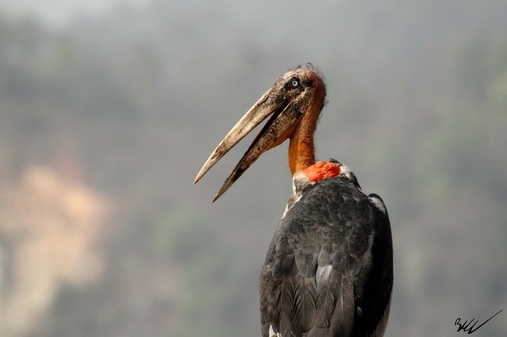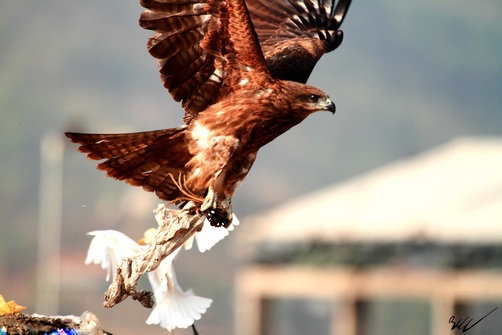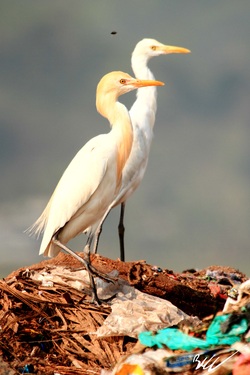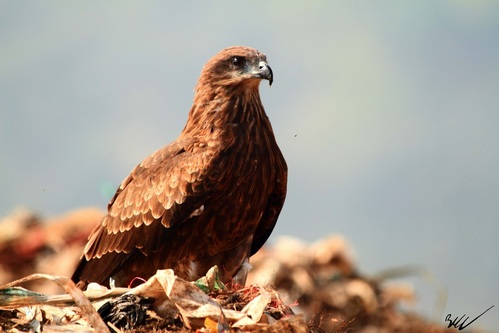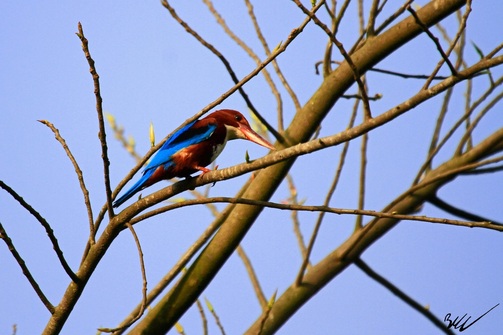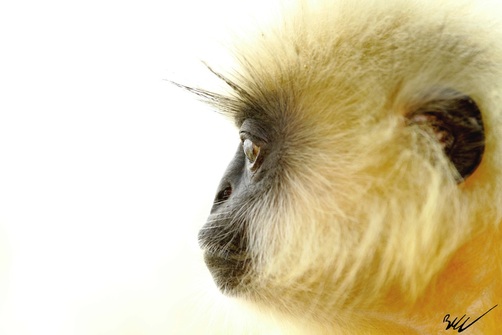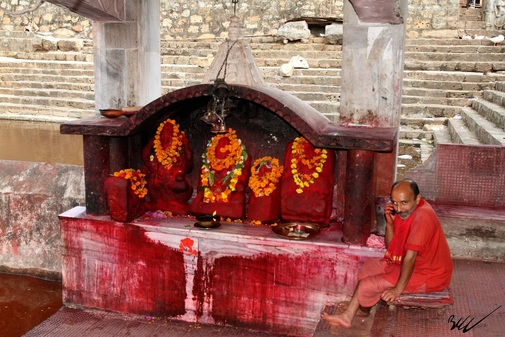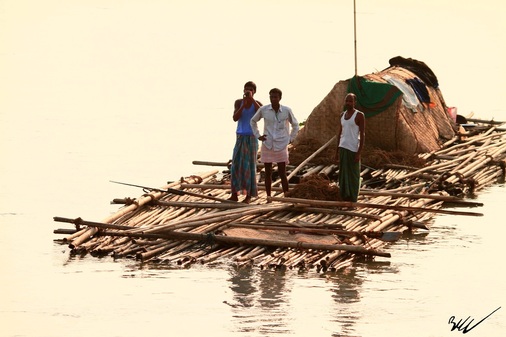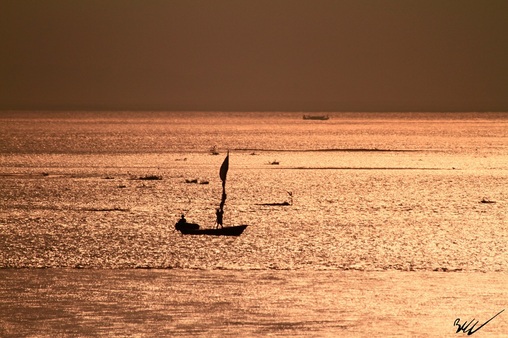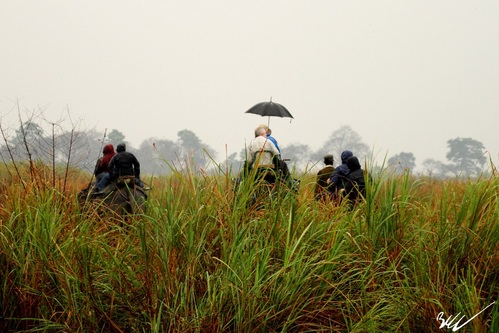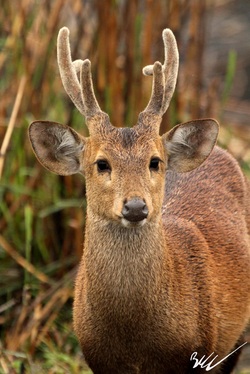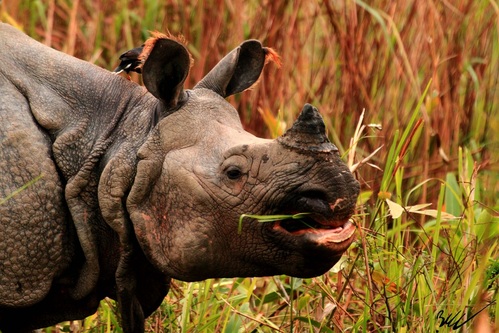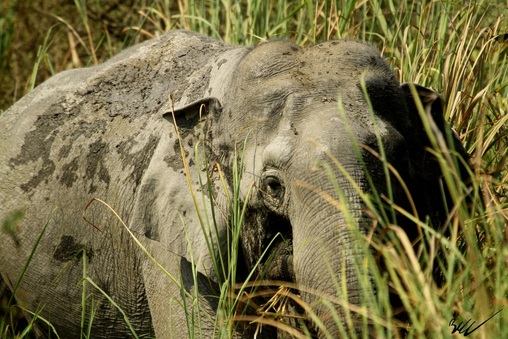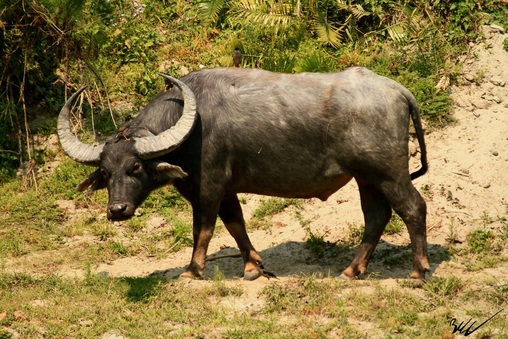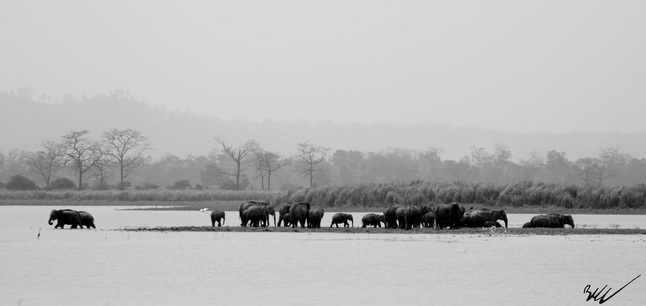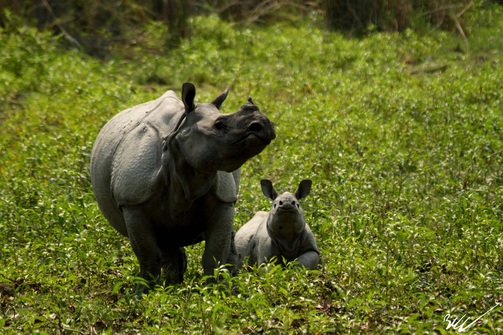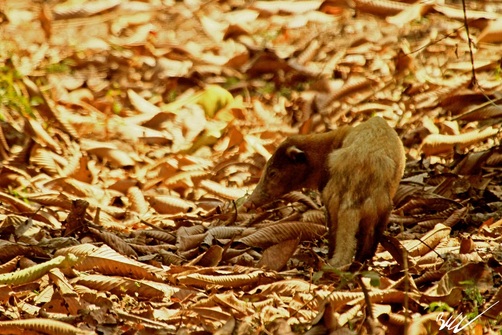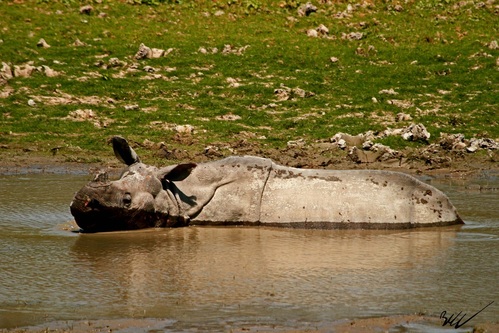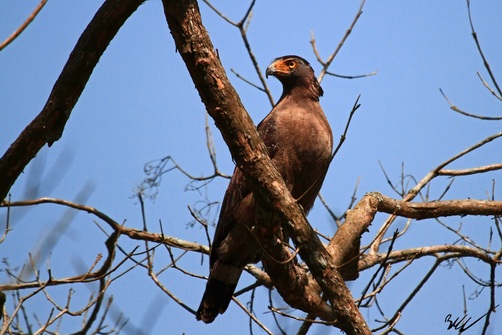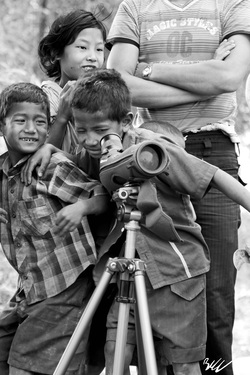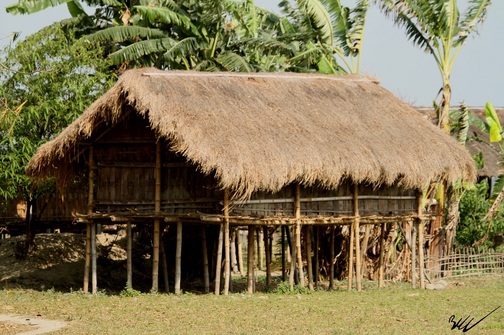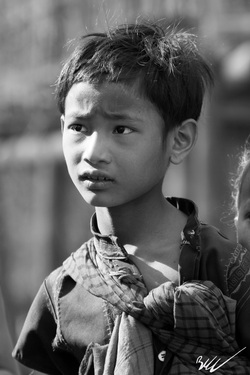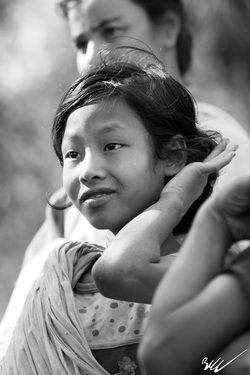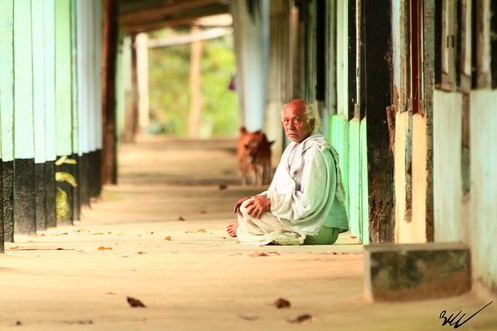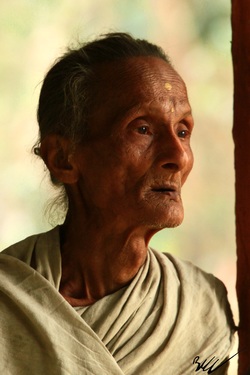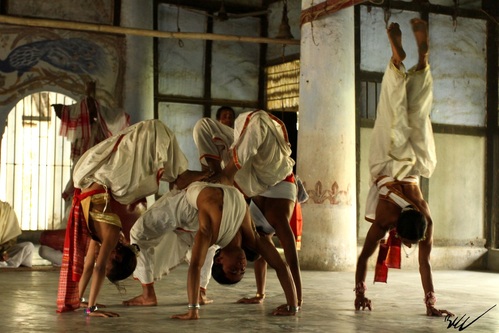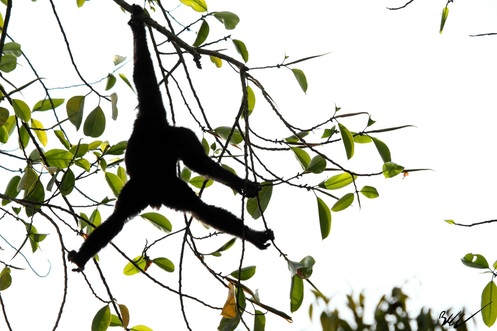|
We had our final breakfast on board our vessel, Charaidew, and everybody was given the choice as to whether they wanted to go and see the critically endangered Greater Adjutant Stork, which has a stronghold at Guwahati rubbish dump or stay on the boat. Some of the ladies in the group rejected the opportunity and decided to stay onboard but everybody else was keen to get a glimpse of these massive birds. We drove to the dump with the help of our minibuses and the first thing we saw when approaching the site, were hundreds of Black Kites circling above. Then as we reached the edge of the dump, we could see the Bangladeshi migrants, who have built their homes of rubbish and live among the rubbish, moving around the rubbish heaps. For some it was hard to see people living like this but unfortunately this is a relatively common sight in India and many other developing nations around the world.
Then we got our first sight of these rather ugly storks. They towered above some of the local women and I struggled to get a photo due to the minibus' movement. As we stopped and caught the stench of the dump in our nostrils (making everyone gag), one of the locals scared all the storks away so our photo opportunities were limited. The birds had flown deeper into the dump and one had to climb the rubbish to get closer, instead I focused on the Cattle Egret and Black Kites. After ten minutes or so most people had had enough of the smell and the tour leaders decided we should return to the boat to collect our belongings and make our way to the airport for our flight to Kolkata (Calcutta). The flight went without any difficulties and we transferred to the Hyatt hotel in Kolkata. This was where I said goodbye to the group and I was to catch the Azur Hind Express train to Nagpur, in central India. My driver and local guide got me to the station safely and found out that my train was delayed by 7 hours. After a couple of hours I was at a hotel, close to the station, for a few hours rest. The drama was to continue the following morning.
0 Comments
Today we were able to have a little bit of a lay in as we were moored relatively close to our first destination. After some tea we left the Charaidew on foot and headed off for a walk around a local village in search of some birds. Myself and a guest (a keen photographer) seperated from the main group and went in search of some photo opportunities. We came across a number of bird species and took a few photos for identification and some particularly nice shots of a White-throated Kingfisher.
We had our breakfast on the boat as we cruised down the river to Peacock Island where there is a Hindu temple perched on the top of some rocks. We were given a tour of the Island but the main attraction was definitely a group of Golden Langurs which have learnt to take food from the temple's visitors. These monkeys are wild but they have become accustomed to human interaction and show absolutely no fear. We then sailed a few hundred metres down river to the river port of Guwahati, where we moored up against the river bank. Within minutes we had attracted a crowd of spectators and in moments two guests were on the shore meeting the young local women. They then got the women to call me down and I reluctantly did go and meet the locals. They then asked me to marry them even though they had husbands and children. After this humiliating moment they took us on a tour of their community which was spotlessly clean. We later found out this was a railway workers housing project so the standard of living was comparatively good to other places in the city. We were quickly escorted back to the boat for lunch by the crew of Charaidew before we got a proper tour, this was a real shame but we went back for our lunch. After lunch we had another temple tour lined up but this time at a very famous Hindu temple. People travel from other parts of India to visit Kamakhya Temple as it is regarded as a particularly "holy" site. At this particular temple they sacrifice male goats in honour of the gods and as usual we had to take our shoes off before we entered. There were people and goats everywhere and it was a particularly smelly, probably due to the animal carcasses. This afternoon there were no more sacrifices to the relief of several people. On these two days the weather was just awful, there is no other way to describe it. The first of the two days was in Nameri National Park and we had a long transfer from the boat to the river, which marked the edge of the park. The plan was to gently glide downstream in some inflatable rafts with the river's current. Due to the heavy rain the river was flowing fast but none the less we went ahead with the boat ride. Two people sat in a raft with two local paddlers at the rear. Within half an hour the heavens opened and by the end of the two hour boat ride everybody was very cold and completely soaked.
Everyone was happy to get back to the boat and we all spent the afternoon in the warm and dry saloon. It really was a day of disappointment for everybody which was a real shame. Normally this day is meant to be the highlight of the trip and a truly wonderful activity. The second day we had a jeep safari in Orang National Park. At first it seemed a little brighter and after a long transfer using the day boat we met up with our 6 jeeps. As usual the jeeps split into two groups of three and we planned to meet in the middle of our circular route. After ten minutes driving our lead jeep was stuck in a dip in the road, digging itself a deeper hole as the driver revved ever harder. After nearly an hour we had managed to get all three jeeps through and met up with the others. We narrowly missed out on a tiger sighting which would have been a very rare opportunity as there are only thought to be ten tigers in the whole park. In the afternoon when we got back to the boat the weather had improved and we had a beautiful cruise down river to the city edge of Guwahati. On the way we saw some bamboo rafts which would then be sold for scaffolding in the city. Today was our final day in Kaziranga National Park and we had arranged and elephant back safari to get really close to the Rhino. The weather today had taken a turn for the worse and it was rather cool with heavy rain. The forecast for the next few days was the same so everybody who had waterproofs took them and those that did not took umbrellas. Assam is the wettest place on Earth so a little rain is to be expected, even in the dry season.
We went out on the Elephants and got close to a number of the Rhinos but after an hour or so with everyone soaked through, legs stretched from straddling the elephants and rather cold we disembarked our four legged friends and went in search of breakfast. On the elephant backs we were lucky enough to see a Bengal Florican, these birds are on the brink of extinction so it was a real privelege to see one. We went to a nearby lodge for breakfast before transferring for about an hour to the Western range were we had another jeep safari lined up for us. The weather had decided to clear up a little for this outing, much to everybody's relief. We got some great sightings of the Rhinos, one was actually closer to us than when we were on the elephant back safari. In the evening when we were back on the boat I managed to electrocute myself after turning on my room's light. I flew across the room and hit the other wall, this was not a pleasant sensation at all and for the rest of the evening my left side was dead. Today was our second day exploring the unusual landscape of Kaziranga. This park consists of tropical lush forest and large tracts of grassland. This grassland is primarily made up of Elephant Grass, which as its name suggests is as tall as an Elephant. Once an animal moves into this grassland it is nearly impossible to see it until it decides to show itself. This time we were visiting the central range of Kaziranga which was over an hour drive from the boat.
Today we got much closer to some wild Asian Elephant and I was able to get some photographs through the extremely high Elephant Grass. The Rhinos also decided that today they would co-operate a little better and I was able to get some nice photographs of a mother and her calf before a vehicle spooked them and they disappeared in the wall of grass. The light was not particualrly favourable as the Sun was rather bright at this point but it was a wonderful moment anyway. After our drive we headed to a nearby lodge for lunch and we were able to give a tame elephant a bath, or in my case photograph the bath. On our way back to the boat we visited a tea plantation and stocked up on some Assam Tea and fresh Peppercorns. In the evening the local villagers came to show us a traditional dance which was both very loud and also a rather colourful affair. Today we were to go on our first adventure into Kaziranga National Park. This wild place in Assam is home to around 80 adult tigers and nearly 2,000 Greater One-horned Rhinos. The other famous inhabitants of the park are, Pygmy Hogs, the Bengal Florican, the mighty Asian Elephant and the increasingly rare Asian water buffalo.
We had a very early start with a transfer from Charaidew to the park boundary with the help of our day boat (country boat). When we got to shore there were 6 jeeps lined up on the bank waiting to take us into this wilderness. I shared my jeep with my room mate and off we went into the park to look for the amazing armour plated One-horned Rhino. These animals are critically endangered and around 2/3rds of the world's population live in this one national park. The most unusual sighting of the day was a Hog Badger, this is a strictly nocturnal animal that is almost never seen and hardly ever photographed. I was also lucky and got to see plenty of the Rhino, Elephant and Buffalo as well as many species of different deer (including the Muntjac). The photos below include the Hog Badger and some of the other local wildlife. Today was going to be another day of culture, we had sailed the evening before close to an island with a traditional Mishing village (the native people of Assam) and moored ourselves to a sand bar. This island had never been visited by a group of tourists before and out cultural guide was unsure when they would have last seen a white person in the village. Today they were going to get a big shock as there were going to be 23 white europeans descending on their quiet island home.
When we got there, the first thing we noticed were their houses, they were a traditional stilt house design that you would imagine seeing in Vietnam or Burma. We met only a few people to start with and they were certainly as intrigued by us as we were intrigued by them. One of the group had brought a spotting scope with him and soon there were local children and adults alike fighting to look through the scope. This was a group of westerners seeing a completely different culture to our own with very little western inluence. To our amazement many of them did have a mobile phone and a few of the richer families had a motorbike. They were a farming community and the island was covered in rice paddies. By the end of our tour around the village (a couple of hours long) the Naturetrek group had around 200 villagers following them and asking us to pose for them so they could take pictures using their mobile phones. I took hundreds of portrait shots that day but I have only included a few here. I am planning to create a gallery just for those portraits. After a great night sleep on board our river boat (Charaidew) we had a busy day ahead of us. Today we were moored off the island of Majuli in the middle of the Brahmaputra River. Majuli Island was once the largest river island in the world and it has its own road network, series of towns and its own culture. It could almost be a country in its own right when you compare its size to some European countries.
Our aim today was not to focus on wildlife, although we did see plenty of birdlife, but to try and see some of the cultural elements that make this place so interesting. We had arranged two monastery visits and at the second a traditional dance-drama had been arranged by the monks. The first monastery (Auniati) was not all that impressive but it certainly gave you an idea of what was involved and the way in which the monks lived and worshipped. These were Hindu monasteries so of course one had to take their shoes off and walk across the muddy floors barefoot. The second monastery (Kamalabari), were the dance-drama was performed, was a little more historic but still consisted of a tin roof on the main prayer area. It is important to respect their beliefs and make sure you abide by the correct rules when entering the prayer buildings. One must take of their shoes before even entering the monastery's grounds and then when the prayer hall you must only walk around the edges and never cross the middle of the room. We all sat down around the edges of this large prayer hall when some of the older monks started to play the drums. Four young boys came out, looking very feminine, and performed this story telling dance which consisted of "extreme yoga". A very interesting day and very different from the Gibbon Sanctuary the day before. This trip shall be as diverse as Assam is itself. I have attached a few photos below showing a couple of monks and a photograph of the dance performance. My first day to experience Indian wildlife was in the state of Assam in Northeastern India. Assam is very different from the majority of India and although it is largely Hindu there are many different cultures and religions. The mighty Brahmaputra River runs through Assam from Tibetan China and this would be my route, by boat, through this fascinating state.
Assam is very famous for the fine tea plantations that cover great swathes of the region and the people look like they are much more closely related to people from East Asia rather than the Indian Subcontinent. This is a truly fascinating area of India to visit and very few people do, maybe this is why Assam has an appeal unlike anything else in this diverse country. Below I have included some images of some of Assam's most beautiful wildlife, the Hoolock Gibbon. These are India's only species of Ape and they sing the most beautiful duets. It took us a few hours to find them in the thick rainforest of Mariani Gibbon Sanctuary which is now only a small pocket of what was once a huge forested landscape. Later the forest rang with the sound of Gibbons, calling out to others to tell them that this was their patch of forest and they are fit and healthy and ready to defend it. This Gibbon duet is amazing and a recording just does not do it any justice at all. A wonderful day in this beautiful forest was had by all and the morning was one that I would certainly never forget. |
AuthorBret Charman Archives
July 2024
Categories
All
|

